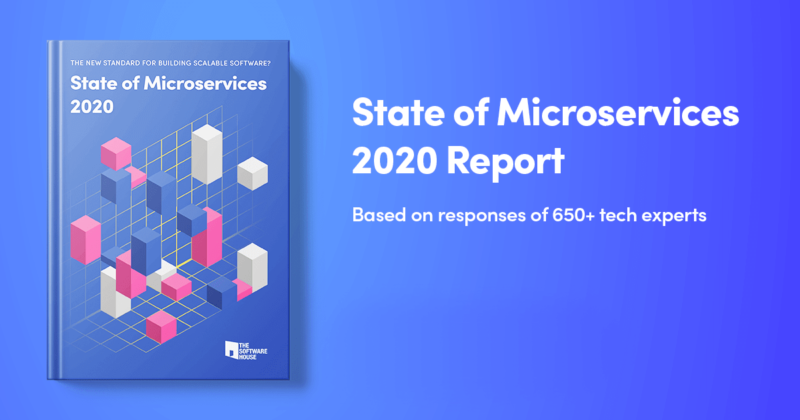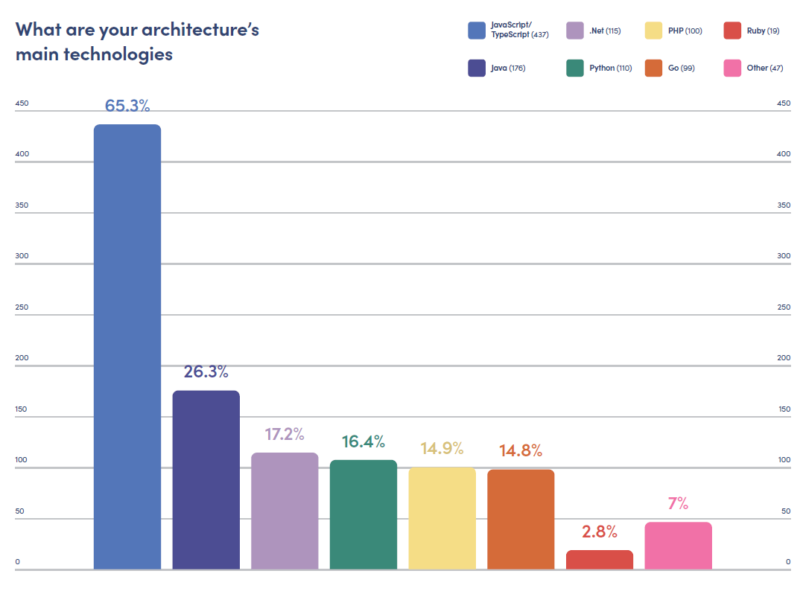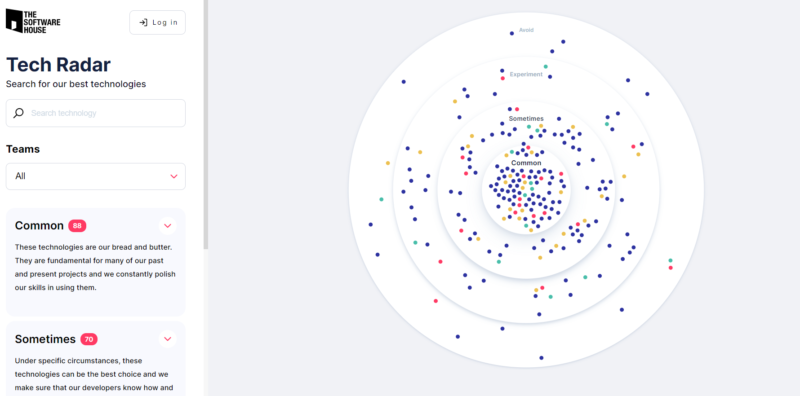20 May 2021
All about #2... microservices architecture – know this before adopting it in 2021
Microservices – not so long ago this word functioned as a buzzword in the minds of many developers and business people, who wanted to reap the supposed benefits of this architecture, even though they really didn’t fully understand what microservices actually are. Today, there are tons of companies that made microservices part of their everyday reality. But is it really all roses for them? How much of their experience with microservices in 2021 is made of struggle?
If you haven’t started following The Software House blog today, you’re probably aware that we wrote a fair share of articles about microservices.
It’s hardly surprising, considering that we made microservices a huge part of our approach to software architecture. We also love Node.js – a JavaScript framework that goes with microservices like peanut butter goes with jam (or pierogi with onions and bacon, considered a regular breakfast at our company[1], if we insisted on our Polish roots). We even made an entire report on microservices based on a survey of +650 tech leaders. In addition to that, we are an official AWS Select Consulting Partner.
Having said all that, we felt that we needed an introduction article for CTOs and other decision-makers who still ponder whether microservices are the step in the right direction for them. Below, you will also find a full list of all microservices-related articles we have ever written! Take your time exploring the potential of microservices in 2021!

What is microservices architecture?
Microservices are a popular variant of the service-oriented architecture, in which the application is arranged as a collection of loosely coupled services.
Want a more descriptive explanation? Imagine a huge corporation. It probably has some departments responsible for specific areas such as IT, Human Resources, Finances etc. Each department has its own culture, backlog and processes. When you need to do something related to IT, you call them. When you need to check an invoice, you go to Finances.
Those are microservices. A relatively small application, responsible for a specific domain. That way, each problem can be taken care of by a resource specialized in that one problem only. You can design your architecture around business capabilities – each service becomes an independently deployable domain organized around business capabilities typical for each departement of your organization. Services can be deployed entirely separetely and they are often loosely coupled, which means that separate components of the system has little to no knowledge of each other.
For a more technical explanation of microservices architecture, read the “Advantages and disadvantages of using microservices architecture” article linked at the end of this post. You can also read other highly esteemed authors such as Martin Fowler, who wrote extensively on microservice architecture in his career.

Benefits of service oriented archicture compared to monolithic architecture
This architectural style, presenting an entire application as a collection of independently deployable services, gives your team unique opportunities. As such, microservices provide developers and businesses with a plethora of benefits:
- Unlike monolithic application, microservice architecture gives us the flexibility needed to scale a single part instead of the whole application. You can tune up the resources required for a specific microservice.
- By splitting the whole app into smaller pieces in a microservice architecture, it is easier to maintain and develop it. It also has the additional benefit of error boundaries (each error will be limited to only one particular piece of the application ).
- By having more small apps, we also can scale up the team easily. No more huge code conflicts typical for a monolithic architecture; no more long deployments!
One could say that:
A good microservices architecture will narrow a failure of the whole system down to a feature related to that specific service only.
The rest of the app built with the microservice architecture style foundation should work just fine.
- Only microservices architecture gives us the option to use the best suited technology for a specific job. We could have a microservice architecture in Go for some low-level computing operations, some microservices in Python for ML-related job, and a Node.js microservice for real-time/api communication. Microservices mean flexibility in the choice of technology stack.
Interested in the entire software development stack from TSH? Check our Technology Radar and find out what technologies we recommend and like best!

Should your company use microservice architecture?
Most of the time, we hear that microservices are good for large applications. Our experience shows something different. There is no point in having a lot of microservices if you don’t have a specialist able to handle them. It applies to developers as well as DevOps engineers.
Let’s be honest – microservices are hard to set up. They require extensive architectural knowledge, proven infrastructure experience, etc. The decision to join the “microservices club” should be based on the size of your application and also the size of your team.
If your business domain is complex and there are clear boundaries between departments, or if you plan to have some advanced processing in your app that could be delegated somewhere else, then microservices are a good choice for you.
Microservices are meant for companies that need to grow up and be able to scale up the application and the team horizontally.
If you have a relatively small company with a few developers who have no previous microservices experience, I would recommend sticking to a modular monolith – the type of architecture that sits between the good old monolith and microservices.
There is also another option that is much closer to microservices, yet doesn’t require great DevOps involvement in your project – serverless. This framework is probably one of the best options available for a small company that needs to cut down on the initial cost of development while retaining the flexibility for future scaling.
Microservice architecture trends & predictions
One of the coolest things about software architecture is that it doesn’t change so often. Something that might be worth mentioning is the growing importance of data-driven architecture that uses a data lake.
We see this as a trend that will probably become a standard in the future, so it’s an area worth exploring.
The cloud is the undeniable future for microservices. Both AWS and Azure are adding new services. A few months ago, AWS announced the Fault Injection Simulator, which is a specialized service to test your microservices resilience.
Every few months, we see new changes to the serverless approach, which is getting more and more popular. This also marks the beginning of nanoservices – something that was considered an anti-pattern that became a popular solution thanks to a range of serverless functions.
How to find a company that understands service oriented architecture?
I would say there are three main challenges to being good at microservices architecture development. These are also the factors that you need to consider when finding the right company to help you with microservices architecture:
1. You need people capable of designing microservice architecture. Such architects should have previous experience with different communication options (APIs, queues, events etc.) and patterns of architectural style (API Gateways, sagas, backend for frontends).
2. Then, you need developers to build such an service oriented architecture. Look for a developer who knows how to work with multiple microservices, test the integrations, build a continuous integration pipeline, but also understands the patterns behind such an approach.
3. Then, finally you would need DevOps Engineers who would focus on monitoring infrastructure as code and making your infrastructure highly available, high-performing, and resilient.
If any of those three ingredients are missing, then your company won’t be able to engage in microservices-based projects.
All microservices articles from The Software House!
And that’s it for the introduction to microservices! Still not sure what to do? Well, one way to go about it is to schedule a free and confidential call with our cloud-certified development team that deals with them day-by-day to define how you can make your project successful.
In addition to that, you can check out all of our microservices-related articles prepared by TSH’s senior developers. They will help you make educated choices regarding microservice-based architecture.
Did you know that debugging is among the most troublesome aspect of microservice development for many devs? Or that micro frontends are becoming an increasingly big trend in modern development, but still only 24% of programmers have ever used them?
What are microservices exactly and how do they work? How are they different from the traditional monolithic-based approach to web development? What does it mean when services are deployed independently? How do they affect business capability? Distributed systems do provide benefits, but they also cause additional complexity in terms of deployment, management, communication and more –a small team may not be able to handle it. In this article, we’re going to guide through the basics of using microservices systems. We’re also going to talk about distributed systems more generally.
Design patterns standardize the use of microservices and make it easier to use them to their fullest potential. However, some of them may be better choices than others in specific scenarios. Our developers are analyzing the most popular design patterns – an essential read not just for developers, but CTOs and other C-level decision makers as well!
Now that you’re sure about migrating your monolithic architecture to microservices, you need to prepare yourself. Making the right decisions from the start is going to have a great impact on the scalability and performance of your app. Practical guide for moving from monolithic architecture to one based on services deployed independently and all the important technology stack decisions involed.
Moving from monolithic application to microservices requires a whole lot of different decisions that affect your entire application, individual service or set of services. Some of them include choosing specific software architecture design patterns, service discovery, service decomposition, service bus, solving data flow problems for the entire system and specific part of the application, choosing infrastructure, establishing debugging methods and monitoring, continuous delivery of the code, among many other things.
From our State of Microservices 2020 report, we were able to determine that testing is a major challenge for many developers and businesses working with microservices-based systems. In this article, we’re analyzing why and providing practical insights that will make your experience with testing microservices easier. It involves various decisions that affter the entire application as well as different services.
Design patterns make it easy to make sense of microservices. They provide best practices in architecture that you can use to create efficient and scalable applications. In this Q&A, we’re answering questions about design patterns such as REST API Gateway, or Backend for Frontend.
Is it difficult to get a job at a microservice-oriented company? Well, you might expect a lot of specialized questions and JavaScript-centric approach to solving backend problems. Adam Polak, TSH’s Head of Node, offers a thorough overview of a interview for a microservices expert candidate.
gRPC is a framework that makes it easier to solve various issues with communication between services in a microservices-based architecture. While typical for Node.js, the gRPC technology can be used for other programming languages such as PHP. Here is a quick and practical gRPC for PHP tutorial!
Want a gRPC for microservices tutorial that doesn’t focus on PHP? Here you go! In this article, you will learn how to use gRPC to solve a variety of challenges with microservices, regardless of what kind of language you use. Works for JavaScript with Node, C++, Java, Python, Ruby, Go, and many more.
As our State of Microservices report proves, testing is a major issue for companies that build microservices-based web applications. You can improve your integration tests for the entire system and individual services for your microservice architecture using Docker as explained in this practical guide.
Microservices have tons of benefits for ogranizations in terms of performance of scalability when compared to monolithic architecture. But it all comes at a price in other areas such as data management. In order to benefit from microservices, you need to understand patterns of event-driven communication in microservices software systems. Practical overview of distributed system for devs and CTOs alike.
[1] Just kidding!!!
Are you interested in developing microservices-based application?
Contact TSH and get free advice on how to go about it. Perhaps, you will stay for longer than you think!

